Map Representations:


Bar Graphs:
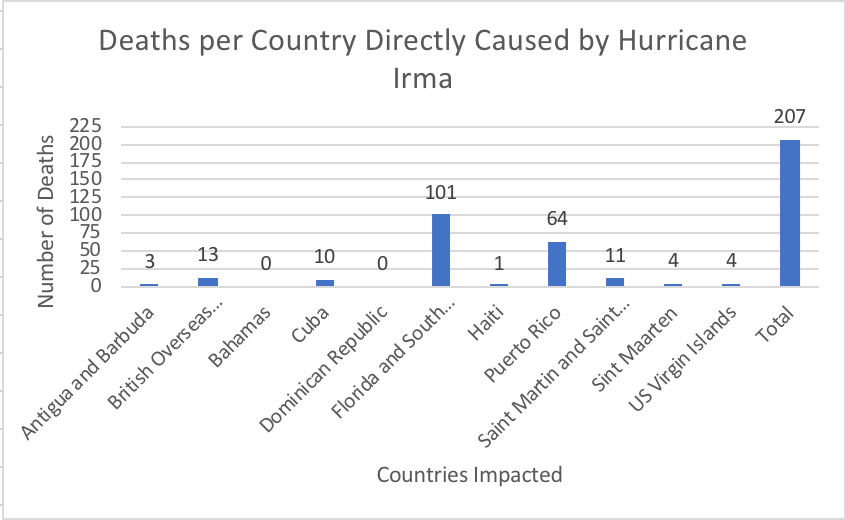
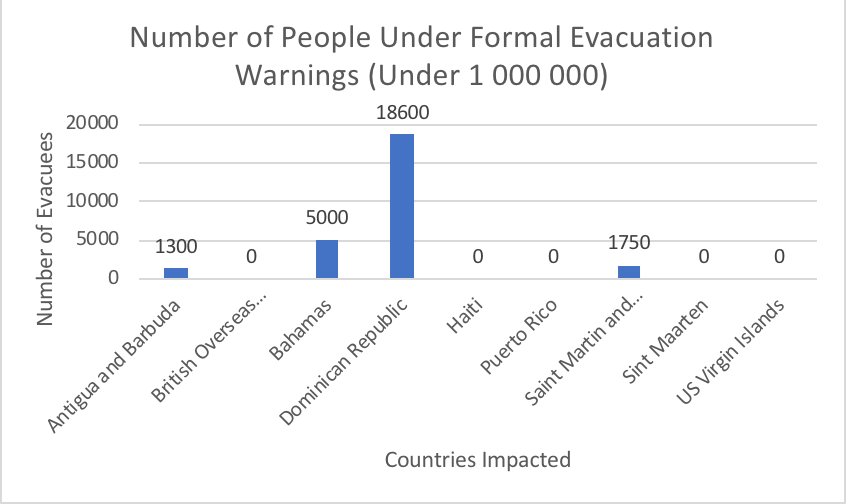
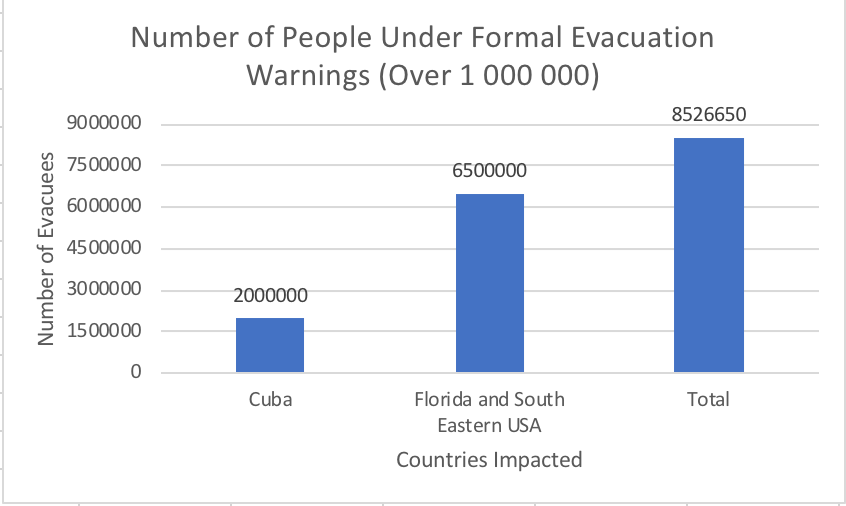
Pie Charts:
Series 1:
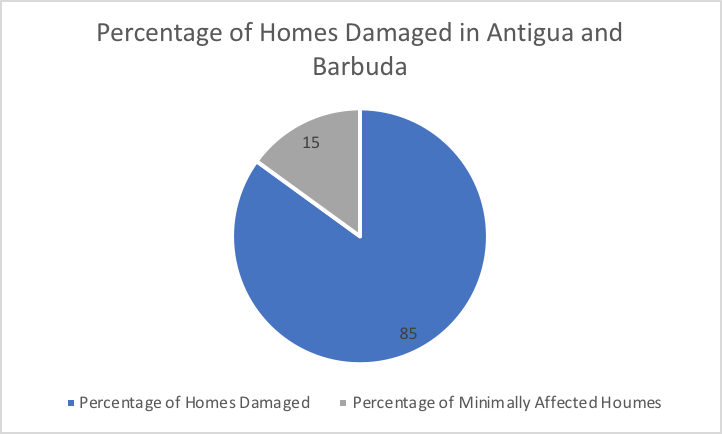


Series 2:


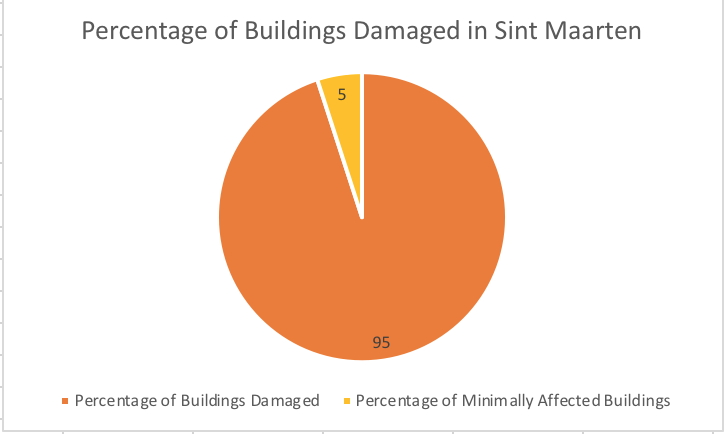
Series 3:

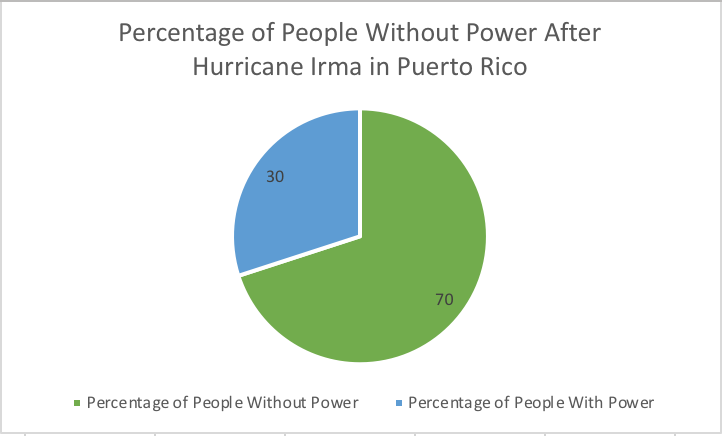
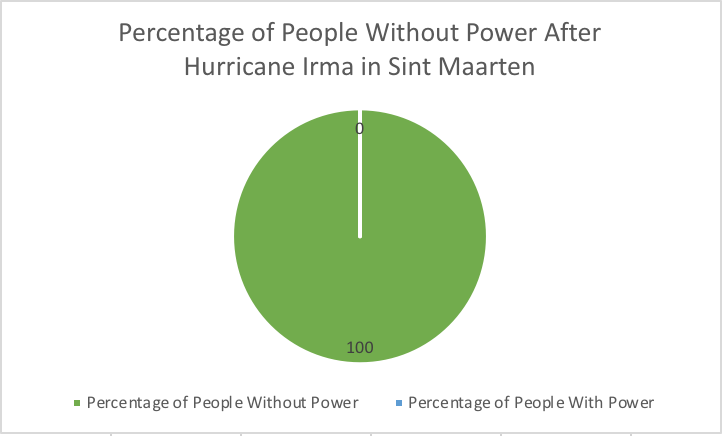

Write Up:
The three graphic representations display the strong interconnected relationships Hurricane Irma had on population, quality of life and the environment. All three representations show that the areas which were most directly hit by the hurricane were those where the impacts were felt most heavily. On islands such as Barbuda and Saint Martin where the eye of the storm directly passed, the extensive property damage was just one example of how this terrible environmental catastrophe impacted the population and quality of life.
The first map displays the relationship between the intensity of the environmental catastrophe and the living standards of those impacted. The red in the map represents the areas affected by Hurricane Irma. The bolder the colours, the greater the costs incurred due to damage by the storm. The economic losses and costs of rebuilding can be used as a way to understand the severity of the damage done. Due to the severity of the storm, many families lost their homes, possessions and access to power and water. In less developed countries, many survivors reported disintegration of law and order, with many facing dire insecurities of housing, food and water. All of these terrible implications of the catastrophe clearly had profound effects on the citizens’ quality of life. This information is delineated as economic losses, as they represent total personal, business, infrastructure and government losses. While this may help provide an example of the greatest losses among the countries, it is important to compare the economic losses of this environmental catastrophe with the GDP of each country to fully understand how individual countries fared.
Due to their sheer size, development and extensive infrastructure, it is expected that regions such as Florida and Cuba would suffer far greater economic losses. To understand the true losses of each individual country, however, it is necessary to compare each region’s economic losses with its GDP. For this reason, the second map displays the GDP of the countries struck by Hurricane Irma. Using these two visual representations, audiences are able to understand how much more devastating this environmental disaster was to the less developed countries with significantly lower GDPs. Furthermore, in combination with a representation displaying the pathway and forces of the storm, audiences can understand the correlation between the course and strength of the storm, and the causation of the detriment of the quality of life of those affected.
The first bar graph displays the number of deaths directly caused by the storm. Some of the first deaths took place during the preparation for the storm. A man in Florida sustained fatal blunt-force trauma due to high winds knocking him off his ladder. Some died in car accidents while fleeing the predicted path of the hurricane. Many others suffered fatal carbon dioxide poisoning from the generators they were required to use when Irma knocked out power lines. It has been speculated that the reported death toll is only a fraction of the actual number of fatalities. Similarly, in Puerto Rico, funeral home directors reported 499 deaths that they believed were directly due to the storm, a total far greater than the 64 deaths documented by Puerto Rican officials.
The second bar graph displays the number of people under evacuation warnings in the areas that had been forecasted to be affected by the storm. Unfortunately, many regions such as Sint Maarten have not disclosed or made the evacuation statistics and totals public. Furthermore, in countries such as Haiti, due to less sufficient emergency response systems, there were no mandatory evacuation orders in place. In these cases, evacuation was done by choice. Consequently, many local citizens remained in their homes, fearing that they would lose everything. Because of this, in the second bar graph, there are a number of countries that have no evacuees reported. It is important, however, to understand the true magnitude of the evacuation due to Hurricane Irma. In tourist driven regions such as the Dominican Republic, officials from countries such as Canada and the United States urged their citizens to either return home immediately or seek shelter before the storm hit. In other countries like the Bahamas, citizens were transferred away from more isolated and less developed islands to prevent loss of life. Further east, Hurricane Irma provoked the largest mass evacuation in US history, with over 6 million Americans under evacuation warnings. Collectively, these two graphs demonstrate the truly catastrophic destruction that Hurricane njIrma wreaked on the population of the areas pulverized.
Finally, the pie charts display the relationship between population and living standards. The first two series of pie charts show the percentage of homes and buildings damaged after the storm passed through. Unfortunately, very few nations disclosed this information, which is why only a few countries appear in these series. With the statistics available, however, readers are able to get a sense of just how many people were affected by this deadly storm. In the case of the French Overseas Territories of Saint Martin and Saint Barthelemy, 95% of homes were damaged due to the terrible catastrophe. Similarly, when looking at the second series of charts, it is evident that all three countries depicted experienced damage in over two thirds of their total buildings. Finally, the third series of graphs display how such a large population pool was left without power. In Florida, a state with a population of 20 million, over a third of the population was left in the dark after Irma made landfall. All of these examples display and strongly suggest that when large sections of the population experience displacement or loss, the quality of life of the entire region is significantly affected, as many were left homeless and without infrastructure such as hospitals or access to water following the hurricane.
Together, I believe that these visual representations collectively create a thorough portrayal of the devastating effects that this environmental catastrophe had on the population and quality of life of those in Hurricane Irma’s destructive path. Together, these visuals delineate the interconnectivity and relationship between the environment, population and quality of life. It is indisputable that the environmental catastrophe of Hurricane Irma had massive consequences for the population and the people’s living standards, forcing so many to flee to shelter and robbing others of their access to basic human necessities.
Works Cited
About the National Hurricane Center, http://www.nhc.noaa.gov/aboutintro.shtml.
“After the Hurricane – an Overview of the Damage Irma and Maria Left Behind.” ReliefWeb, reliefweb.int/report/antigua-and-barbuda/after-hurricane-overview-damage-irma-and-maria-left-behind.
Ahmed, Azam, and Kirk Semple. “Desperation Mounts in Caribbean Islands: ‘All the Food Is Gone’.” The New York Times, The New York Times, 10 Sept. 2017, http://www.nytimes.com/2017/09/10/world/americas/irma-caribbean-st-martin.html.
Amadeo, Kimberly. “Hurricane Irma Damage Was $50 Billion.” The Balance, http://www.thebalance.com/hurricane-irma-facts-timeline-damage-costs-4150395.
“Analysis | After Hurricane Maria, Parts of Puerto Rico Are Still in the Dark.” The Washington Post, WP Company, http://www.washingtonpost.com/graphics/2017/national/puerto-rico-hurricane-recovery/.
Berke, Jeremy. “Nearly 7 Million People Told to Evacuate in Florida and Georgia as Hurricane Irma Approaches with 125-Mph Winds.” Business Insider, Business Insider, 9 Sept. 2017, http://www.businessinsider.com/hurricane-irma-florida-evacuation-orders-2017-9.
Huriash, Lisa J. “Florida Death Toll from Hurricane Irma Keeps Rising.” Sun-Sentinel.com, 23 Nov. 2017, http://www.sun-sentinel.com/news/weather/hurricane/fl-reg-hurricane-irma-deaths-20171120-story.html.
“Hurricane Irma: Damage Mapped.” BBC News, BBC, 12 Sept. 2017, http://www.bbc.com/news/world-us-canada-41175312.
“Hurricane Irma Flattens Barbuda, Leaving Hundreds Homeless.” Time, Time, time.com/4935433/hurricane-irma-barbuda-antigua-survivors-caribbean/.
“Hurricane Irma.” Wikipedia, Wikimedia Foundation, 11 Feb. 2018, en.wikipedia.org/wiki/Hurricane_Irma#Aftermath.
Johnson, Alex, et al. “Hurricane Irma Skirts Puerto Rico, Leaves 1 Million Without Power.” NBCNews.com, NBCUniversal News Group, 7 Sept. 2017, http://www.nbcnews.com/storyline/hurricane-irma/hurricane-irma-skirts-puerto-rico-lashing-it-powerful-winds-flooding-n799086.
Johnson, Alex, et al. “Hurricane Irma Skirts Puerto Rico, Leaves 1 Million Without Power.” NBCNews.com, NBCUniversal News Group, 7 Sept. 2017, http://www.nbcnews.com/storyline/hurricane-irma/hurricane-irma-skirts-puerto-rico-lashing-it-powerful-winds-flooding-n799086.
Johnson, Alex, et al. “Hurricane Irma Skirts Puerto Rico, Leaves 1 Million Without Power.” NBCNews.com, NBCUniversal News Group, 7 Sept. 2017, http://www.nbcnews.com/storyline/hurricane-irma/hurricane-irma-skirts-puerto-rico-lashing-it-powerful-winds-flooding-n799086.
Keneally, Meghan, et al. “Hurricane Irma: By the Numbers.” ABC News, ABC News Network, abcnews.go.com/US/hurricane-irma-numbers/story?id=49677062.
Levenson, Eric. “Puerto Rico’s Power Outages Are the Largest in US History, Report Says.” CNN, Cable News Network, 26 Oct. 2017, http://www.cnn.com/2017/10/26/us/puerto-rico-power-outage/index.html.
MailOnline, Julian Robinson for. “’It Is Just Total Devastation’: Category 5 Hurricane Irma Destroys 90 per Cent of Tiny Island of Barbuda as 185mph Winds Kill Four across the Caribbean and Dump Torrential Rain on US Territories.” Daily Mail Online, Associated Newspapers, 6 Sept. 2017, http://www.dailymail.co.uk/news/article-4857842/Hurricane-Irma-slams-Caribbean.html.
News, Sky. “Hurricane Irma Path: Which Countries Have Been Affected?” Sky News, 8 Sept. 2017, news.sky.com/story/hurricane-irma-path-what-countries-have-been-affected-11023725.
PolitiFact, and Bill Nelson Senator https://twitter.com/SenBillNelson/status/959524862342713344. “Fact-Checking Statistics about Puerto Rico’s Storm Recovery.” @Politifact, 7 Feb. 2018, http://www.politifact.com/florida/statements/2018/feb/07/bill-nelson/fact-checking-statistics-about-puerto-ricos-storm-/.
Port-au-Prince, Associated Press in. “Turks and Caicos Islands Hit by Hurricane Irma.” The Guardian, Guardian News and Media, 8 Sept. 2017, http://www.theguardian.com/world/2017/sep/08/turks-and-caicos-islands-hit-by-hurricane-irma.
“Puerto Ricans Are Losing Power as Island Fights to Recover from Hurricane Maria.” The Week – All You Need to Know about Everything That Matters, 24 Oct. 2017, theweek.com/speedreads/732984/puerto-ricans-are-losing-power-island-fights-recover-from-hurricane-maria.
Sweeney, Dan, and Lisa J. Huriash. “The Many Ways People Have Died from Hurricane Irma.” Sun-Sentinel.com, 25 Sept. 2017, http://www.sun-sentinel.com/news/weather/hurricane/fl-sb-deaths-irma-florida-20170920-story.html.
Thompson, Isobel. “Florida Officials Fear ‘Humanitarian Crisis’ in Irma’s Aftermath.” The Hive, Vanity Fair, 12 Sept. 2017, http://www.vanityfair.com/news/2017/09/florida-fears-humanitarian-crisis-in-irmas-aftermath.
time.com/4935278/hurricane-irma-death-toll/.
Willingham, AJ. “A Look at Irma’s Jaw-Dropping Numbers.” CNN, Cable News Network, 8 Sept. 2017, http://www.cnn.com/2017/09/06/weather/irma-hurricane-numbers-stats-trnd/index.html.
Wolf, Colin. “Evacuation Orders Issued for Puerto Rico as Hurricane Maria Closes In.” Orlando Weekly, Orlando Weekly, 11 Jan. 2018, http://www.orlandoweekly.com/Blogs/archives/2017/09/18/evacuation-orders-are-issued-for-puerto-rico-as-hurricane-maria-closes-in.
http://www.bbc.com/news/world-latin-america-41172545.
http://www.cnn.com/specials/hurricane-irma.
http://www.nytimes.com/2017/12/29/us/puerto-rico-power-outage.html.
http://www.thebalance.com/hurricane-irma-facts-timeline-damage-costs-4150395.